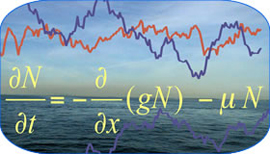Modelling Marine Communities
Developing the biological understanding for an Ecosystem Approach to Fisheries Management
Background and Aims
The Earth Summit in Rio de Janeiro (1992) set a requirement for ecosystem approaches to natural resource management, to ensure sustainability through recognition of the ecological effects of natural resource use and the application of the 'precautionary principle'. This has been adopted by international treaty in relation to commercial fisheries management, establishing the need to replace single stock management with ecosystem-level stewardship.The Republic of Ireland has responded, in part, by funding a multi-disciplinary all-Ireland research programme: the Beaufort Marine Research Award in the ‘Ecosystem Approach to Fisheries Management’. Queen’s University Belfast, School of Biological Sciences was awarded the lead contract in theoretical marine ecology to develop the understanding and mathematical models of marine systems to support fisheries management for ecological objectives.
According to the UN FAO (Fisheries Technical Paper 477), the ‘Ecosystem Approach to Fisheries Management’ requires us to: manage fisheries to limit their impact on the ecosystem; maintain ecological relationships among species across legal and social jurisdictions and use the ‘precautionary approach’ with governance ensuring both human and ecosystem well-being and equity. Achieving all this requires a good understanding of marine ecosystems so that objectively justifiable fisheries management goals can be set for ecological stewardship. Much of this understanding is presently lacking, especially in relation to community and spatial interactions. It is now recognised that commercial fishing may affect the functioning and structure (e.g. productivity and biodiversity) of a marine system, but the mechanisms remain largely obscure. Our seven year programme of research aims to discover, clarify and quantify these mechanisms and especially their sensitivity to fisheries management measures.
More specifically, we aim to provide the necessary and sufficient understanding to limit the impact of fishing on the marine community as a whole, and to preserve biodiversity. We are therefore most concerned with community interactions: predator-prey and competition in an integrated web (not in isolation). Effects such as climate change and pollution may be allowed to influence the model systems we work on, but are not our principle focus; that remains the effect of managed fisheries.
Our approach
Many marine organisms, especially exploited fish, pass through five or more orders of magnitude in body mass during the course of their life-history. The principle community interaction defining the lives of these organisms is predator-prey and that is determined, to first order, by body-size. Description of marine community dynamics therefore requires explicit account of body-size. Marine communities taken as a whole, systematically show a log-linear relation between abundance and body-size of organisms (individually and summed across all species). The most parsimonious representation of all these properties in a community model is that of a size-spectrum, which captures all the essential features, using the minimum data. Multi-species size-spectrum population dynamic modelling is an active area of international research and our team actively contributes to the networking of scientists developing different implementations of the concept. We are concentrating on the development of a particular implementation called the “fish community size-resolved model” (Andersen and Pedersen, 2010), originally intended for the North Sea. Presently this kind of model is limited in the number of species it can realistically represent, due to mathematical limits to the stability of the system model.For this reason, in parallel, we are developing a unique population dynamic model of an entire marine food-web which has no intrinsic limit to coexisting species number. The Population-Dynamical Matching Model (PDMM), described by Rossberg et al. (2008), is a dynamic food-web model that generates food-webs of thousands of modelled species, parameterised in terms of body size, predation, defence, and several other phenotypic traits. The traits naturally determine the interaction strengths among species in dynamic simulations of ecological assemblies where populations respond to predation and fisheries mortality and feeding resource availability, until a dynamic equilibrium is attained.
Practical Applications
We are focussing on the Celtic Sea system as a test-bed for practical implementations of the models and using the insights we gain through developing the models to suggest useful tools for fisheries management (e.g. Andersen et al 2009). By developing the models in close collaboration with fisheries scientists, marine biologists and governance experts (as part of the Beaufort Marine Research team), we are ensuring their practicality. In particular, we aim to develop practical indices of ecological welfare and descriptions of the ecosystem that are meaningful to practical management. The models are eventually intended to be used as decision support tools - exploring scenarios and predicting ecological effects of management options. To this end we engage with potential users through a series of Beaufort Workshops and take part in ‘stake-holder’ ‘knowledge transfer’ activities. We recognise that sustainable development includes forming a consensus of understanding about the ecosystem and the effects human activities have on it and what we can reasonably do about that.Presently, the team consists of Dr Axel Rossberg, Dr Keith Farnsworth and two PhD students: Tak Fung and Jennifer Houle, all closely collaborating with research partners in other institutions such as the Danish Technical University. We have the exclusive use of a high performance computational biology facility within the School of Biological Sciences at Queen’s University Belfast.
The Work Package is led by Keith Farnsworth with Emer Rogan.
Axel Rossberg is the Beaufort Research Fellow.

